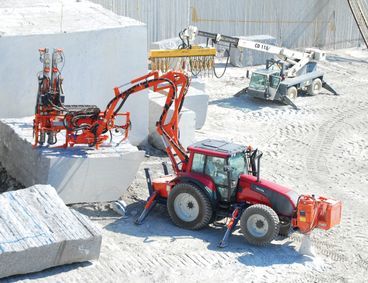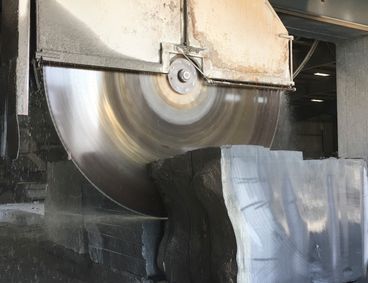How we make it greener Exterior Dimension Stone Cladding
Usable material vs excess process material ratios vary at each quarry and at times the excess exceeds the usable. It is important to know that excess process materials are almost always reclaimed or recycled. It is extremely uncommon for any stone to be diverted to a landfill. The Natural Stone Institute is working with their quarrier members to identify ways to make use of this excess and educate the industry about techniques and product lines that can effectively improve quarry yield.
The design community can also help with this issue. Most natural stone’s have a specific set of characteristics for the most desirable pieces. For example, limestone is generally either buff or gray in color. The blocks that are variegated, containing both buff and gray hues, are less desirable. If design teams are more accepting of natural variation in the material, then there is more usable material, and less excess, available from the source.

Using stone from local sources is the single biggest opportunity to reduce its embodied carbon. Since natural stone is a heavy material, the environmental impacts for transporting it end up being the most significant accrual of carbon. Natural stone is sourced world-wide and each deposit has unique aesthetic and performance characteristics so this is not always avoidable. Be sure to understand the distances between the quarry, the fabrication facility, and sometimes the distribution centers. In most North American operations the quarry is within miles of the fabrication facility. However, some natural stone producers will take advantage of lower labor costs in other countries and ship the stone large distances to be fabricated and then back again.

To ensure the health and safety of our workforce, water is used during quarrying and fabrication to reduce dust and heat. Recycling this water is both environmentally responsible and economical. It is very common for stone facilities to recycle over 85% of the water used in their facilities.
There are a large variety of sizes and finishes that are commonly used for natural stone cladding. Design teams can help to reduce energy consumption in the following ways:
- Appreciate natural color and pattern variations.
- Understand how finishes are achieved and additional work that may be required on edges or adjacent surfaces.
- Optimize panel sizes based on block availability.
- Reduce thickness if possible.
- Avoid complex geometries such as radiuses and solid corners.
- Consult an expert for guidance on most the sustainable ways of achieving your desired aesthetic.

There are endless opportunities for natural stone to be refinished, reused, and recycled.
Since it is durable and full-bodied, the surface of the material can be removed, revealing a ‘clean slate’ free of any sealers or contaminants, freeing them of centuries of pollutants, preserving the historical integrity of the project, and eliminating the need for new construction.
Because of these capabilities, stone rarely reaches an end to its potential service life. When an owner chooses to replace natural stone, it can be removed and altered into an entirely new product and reinstalled in a new location.
There are also stone companies that have ‘take-back’ programs, to divert the stone from a landfill back to a quarry to be used as part of their land reclamation plan. If stone does end up in a construction landfill, there will be no toxic chemicals seeping into the earth as the material degrades. It simply returns to the earth, cradle to cradle.
 SM Transparency Report (EPD)
SM Transparency Report (EPD) 